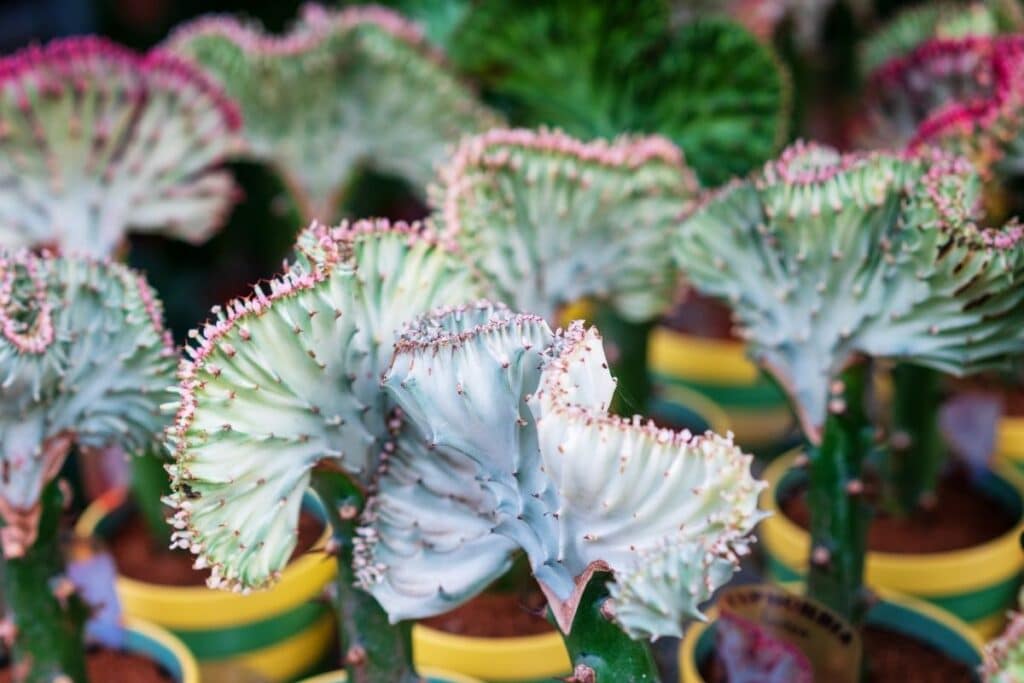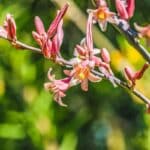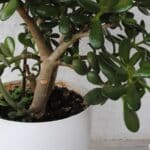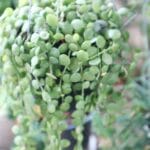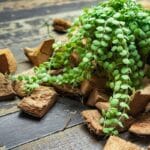If you’re looking to plant a succulent shrub that will stand out against the rest, the euphorbia lactea may be a good option as long as you live in a warm enough climate.
The euphorbia lactea is a tropical plant that looks like a cactus, creating a neat landscaping effect around your home. This plant can also be a good houseplant under the right conditions.
The euphorbia lactea goes by a lot of different names: mottled spurge, dragon bones, dragon bones tree, coral cactus, candelabra spurge, candelabra cactus, crested cactus, candlestick tree, false cactus, hat rack cactus, mottled candlestick, milk stripe euphorbia, and frilled fan. Euphorbia lactea is simply this plant’s scientific name.
This plant is a part of the Euphorbiaceae plant family which is commonly referred to as the spurge family and is a member of the Euphorbia genus and Euphorbiaceae family.
What is Euphorbia Lactea?
Although the euphorbia lactea (Dragon bones tree) may look like a cactus, it is actually a tropical perennial shrub that is native to tropical areas of Asia.
These potted plants have multiple spiny branches that grow in various directions with smaller branches extending from the main stalks. These spiny branches are ridged and do not bend easily, not a plant you want to fall on top of!
The dragon bones tree does produce flowers, but they are fairly small and do not stay very long—overall pretty insignificant to the plant.
To grow your euphorbia succulent outside, you will need to live in USDA hardiness zones ten or eleven. For those who live outside of these growing zones, the euphorbia makes a good houseplant if you’re careful.
All parts of the dragon bones tree are toxic, particularly the sap which should never be touched. When grown outside in optimal conditions that mimic their natural habitat, it can grow to up to sixteen feet tall. If you grow your it inside, it will probably stay closer to two feet tall.
To get your coral cactus plant started, some time and commitment are required as these are not the easiest plants to establish. Once they do become established, however, they are relatively hands-off plants that will rarely require your attention. Soil, water, and temperature are the most important factors when it comes to growing this plant.
How to Care for Euphorbia Lactea
Caring for the euphorbia lactea becomes a fairly straightforward task once the plant has become established. The initial investment that this plant requires will involve some dedication though, as it has some particular needs.
Overall, for the uniqueness that this plant will bring to your garden or home, the outcome is worth the effort.
Watering
There are some specific requirements for watering your euphorbia. In the summer and times of growth it requires at least one watering a week, although it should be monitored to ensure it does not need more or less water.
If the plant starts to turn yellow or brown, it may be receiving too much water, and if it is starting to wilt or wrinkle, it is probably not getting enough water.
During the winter, you may not need to water your crested euphorbia lactea at all. It is common practice to give this plant one last water at the beginning of winter and not water again until spring and summer.
When you do go to water your euphorbia lactea, the most effective method is to soak the soil completely. If your plant is potted, this means watering until water starts coming out of the drainage holes. You should also let the soil dry out in between watering for best results.
Soil Type
A well-draining potting mix is essential for the euphorbia lactea’s survival, as it is prone to diseases that start from wet soil.
Although the dragon bones tree is not a cactus, a soil designed for cacti and succulents is ideal. If you want to use soil you already have, you may want to mix in some coarse sand to increase the draining ability.
Perlite is a naturally occurring mineral that is commonly used to make potting soil drain better, but it also provides some nutrients that can be beneficial to your euphorbia plants.
The nutrient level of the soil is not as important to this tree, but you may want to add fertilizer if you have low quality soil. On the contrary, if the nutrient levels are too high, this can overwhelm the plant, so you may need to adjust accordingly.
Light
Locations that receive partial shade are ideal for the euphorbia lactea, although some full-sun locations may work as well.
When planting in full-sun locations, you may need to monitor your plant for signs of sunburn. Yes, plants can get sunburn too, although it shows in different ways. A sunburn for a plant is also called leaf scorch and is noticeable by dark spots that may become wilted or brittle.
If planting your dragon bones tree inside, a window sill that receives a decent amount of sunlight during the day is probably your best option. If you do not want to keep your plant right in the window sill, a spot in a sunny room may work as well.
Temperature
Since the euphorbia lactea is a tropical plant, climates of similar temperatures are ideal, specifically zones ten and eleven. This plant is not frost tolerant at all, and it would need to be brought inside before frost hits to keep the plant healthy and alive.
When planting in warmer growing zones, the main issue to be on the lookout for is sunburn, or leaf scorch, as warmer summers can increase the severity of the damage.
Providing your plant with shade during the warmest parts of the summer can help to keep it healthy and thriving.
Fertilizer
During the growing season, spring through fall, fertilizer can be added to help give your euphorbia lactea an extra boost. If you do fertilize your plant, you will want to do so once a month but not in the winter.
Fertilizing your euphorbia lactea at this time would be a waste of resources, as the plant is in dormancy during these months.
Euphorbia lactea is also prone to fertilizer burn which occurs when the roots are exposed to high levels of nutrients all at once. It is recommended that you use fertilizer that has been diluted to at least half-strength on your plant to avoid any burns.
Varieties of Dragon Bones Trees You Can Grow
There are a few different types of euphorbia lactea that grow in different patterns and color varieties. These varieties all require similar care instructions but have different looks to them.
Choosing a variety of dragon bones tree to grow will come down to which look you personally prefer.
Euphorbia Lactea Cristata
The euphorbia lactea cristata is commonly referred to as the crested euphorbia, frilled fan, or elk horn. The common names come from the shape of this variety, which is its main difference when compared to other euphorbia lactea varieties.
The branches form in wavy patterns that often grow in an “s” shaped pattern. While most varieties have long and thin branches that grow in varying directions, this variety grows in more of a tight-knit cluster, creating a very different looking plant.
Variegated Euphorbia Lactea
Variegated euphorbia lactea grow in a similar manner and pattern as the traditional variety does. The main difference here is that the colors may vary.
Instead of the traditional green branches with thin white lines, these varieties can come with yellow, pink, and even purple sections. Most of these varieties will still have some green around the base, with the additional color forming towards the tops of the branches.
Euphorbia Lactea Ghost
The euphorbia lactea ghost is actually a form of the variegated variety but is unique in another aspect. This variety is often called gray or white ghost, as a majority of the plant is white in color.
While most variegated varieties only have some additional color, the ghost variety will be mostly white.
Another difference that this variety brings is that it is more susceptible to sun-related damage, meaning it will burn easier. These plants should stay strictly in partially-shaded areas, as they will not be able to thrive in a full-sun location.
Euphorbia Lactea Toxicity
The euphorbia lactea is not a plant that should be kept around young children, as its toxicity levels are high enough that simply touching the plant can cause irritation.
Touching the exterior of the plant will only cause minor irritations such as redness or a slight rash that goes away after some time.
However, there is sap within the plant that can cause a more serious reaction if you come in contact with it. Touching the sap or getting it on your skin can cause redness, rash, swelling, and blisters that may linger for some time.
If you do come in contact with the sap, remove it from your skin as quickly as possible and wash the skin thoroughly.
Ingesting any part of the euphorbia lactea can cause negative reactions as well. Although not deadly, ingesting this plant can cause nausea, vomiting, and diarrhea—not worth the risk.
For these reasons, it is a good idea to keep this plant out of reach of both children and pets, although the spiky exterior is usually enough to deter anyone from taking a bite.
Common Pests and Diseases for Euphorbia Lactea
When it comes to growing euphorbia lactea, there are some pests and diseases of which to be mindful. Most pests, if noticed early on, can be removed easily before too much damage is caused to your plant.
Getting rid of a disease may be more difficult, and prevention is key in these circumstances.
Powdery Mildew
Powdery mildew is a common problem with euphorbia lactea and is primarily caused by poor air circulation, making it a more common problem for inside plants. Powdery mildew can be identified as a white mold-like substance growing on the branches of your plant.
It is important to remove powdery mildew carefully so you do not harm your plant in the process. One way to eradicate this disease is with a baking soda mixture that can be used to wipe away infected areas.
Providing good air circulation for your plant and keeping proper humidity levels are the best ways to prevent powdery mildew from occurring at all.
Root Rot
The roots of the euphorbia lactea are particularly prone to root rot, a disease caused by too much water surrounding the roots.
Plants that are affected by root rot will start to wilt and die. The roots themselves will become dark and soft, and they will no longer be able to provide nutrients to the plant.
Attempting to repot or replant your euphorbia lactea is the only way to treat root rot once it has occurred. When transplanting, carefully clean the roots with a cloth to eliminate the disease.
If only parts of the plant are infected, you can cut these sections off and remove them. To prevent root rot, use well-draining soil and do not overwater your plant.
Mealybugs
Mealybugs are some of the most common pests that will bother your euphorbia lactea plants. These pests will harm your plants by attaching themselves to the branches and sucking out the nutrients—too bad the toxic sap has no effect on these insects.
To get rid of these scale insects, you can use a cotton swab that has been dipped in rubbing alcohol to gently wipe the pests off the branches. When wiping the pests off, use gloves to avoid contact with the plant.
Neem oil can also be sprayed every few weeks to prevent mealybugs from showing up in the first place.
Spider Mites
Spider mites are another common pest that you may find living on your euphorbia lactea. Spider mites are tiny arachnids that can suck nutrients from the branches of this crested candelabra plant, causing harm over time.
For most infestations, you will simply be able to wash the spider mites off your plant with strong sprays of water.
For larger infestations, or if these pests keep coming back, you can use a light pesticide or neem oil spray. Applying neem oil to your euphorbia plants frequently is a good preventative measure as well.
FAQs
Does Euphorbia need direct sunlight?
No, Euphorbia generally prefers bright, indirect sunlight but can tolerate some direct sun light, especially in the morning or late afternoon. However, prolonged exposure to intense bright sunlight may cause its leaves to scorch.
Is Euphorbia lactea a cactus or succulent?
Euphorbia lactea is technically neither a cactus nor a succulent but belongs to the Euphorbiaceae family. It is a succulent-like plant with cactus-like growth habits, characterized by its branching stems and thorn-like structures.
Why is my Euphorbia Lactea turning brown?
Euphorbia lactea turning brown can be due to various reasons, including overwatering, underwatering, sunburn, pest infestations, or diseases. Assessing factors such as watering practices, sunlight exposure, soil condition, and pest presence can help determine the cause and appropriate corrective actions.
How do you save a dying Euphorbia?
To save a dying Euphorbia, first, identify and address the underlying issue causing its decline. This may involve adjusting watering practices, providing adequate sunlight, repotting in well draining soil, treating for pests or diseases, or pruning away diseased or damaged portions. Once corrective actions are taken, monitor the plant closely and continue to provide appropriate care.
How often should you water Euphorbia?
Euphorbia generally prefers to dry out between waterings to prevent root rot. Water it when the top inch of soil feels dry, typically every 1-2 weeks during the growing season. Reduce watering frequency during the dormant season and avoid waterlogging the soil. Adjust watering frequency based on environmental conditions such as temperature, humidity, and sunlight intensity.
*image by depositphotos.com/[email protected]

